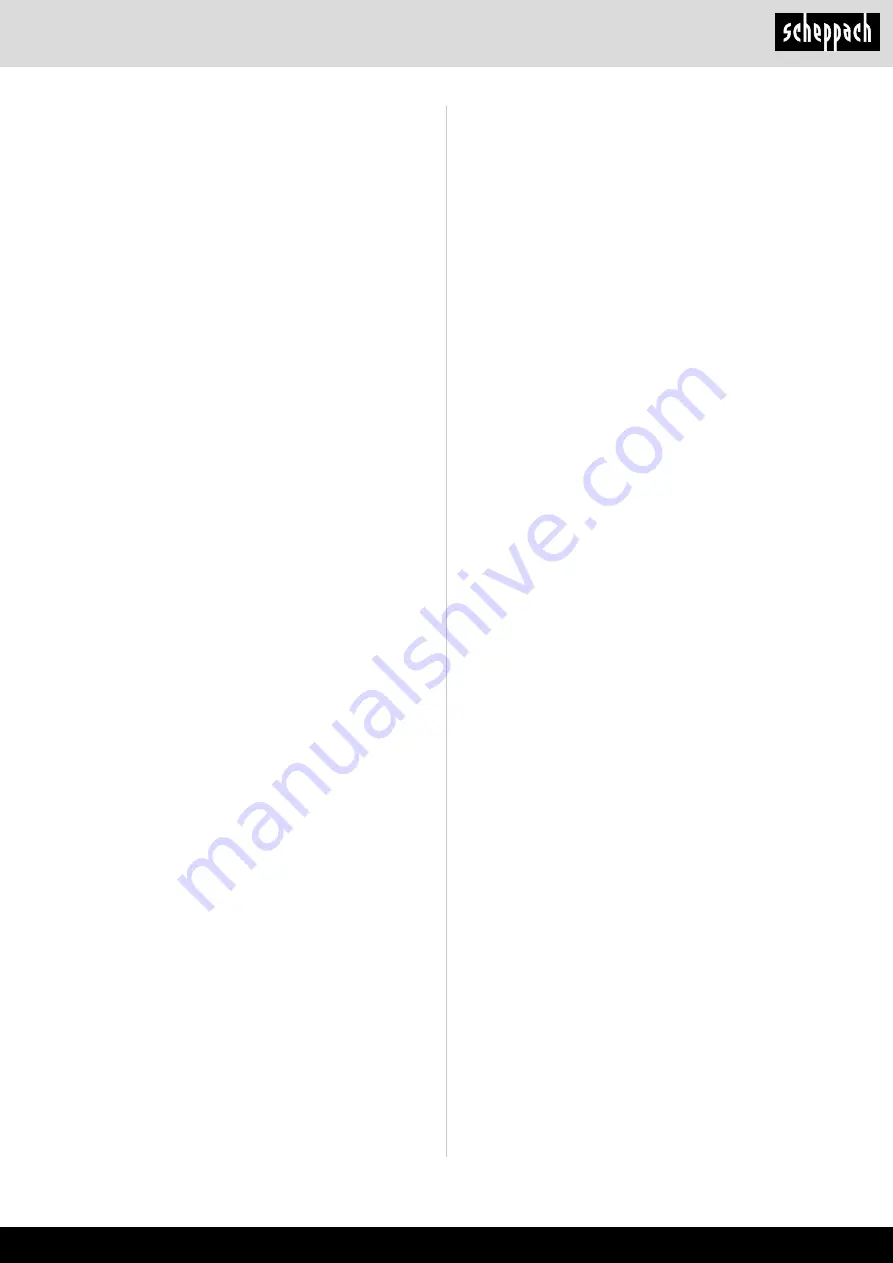
www.scheppach.com /
+(49)-08223-4002-99 /
+(49)-08223-4002-58
GB
| 21
e.
When the wheel is binding or when interrupt
-
ing a cut for any reason, switch off the power
tool and hold the cutting unit motionless until
the wheel comes to a complete stop. Never at
-
tempt to remove the wheel from the cut while
the wheel is in motion otherwise kickback may
occur.
Investigate and take corrective action to
eliminate the cause of wheel binding.
f.
Do not restart the cutting operation in the
workpiece. Let the wheel reach full speed and
carefully re-enter the cut.
The wheel may bind,
walk up or kickback if the power tool is restarted
in the workpiece.
g.
Support any oversized workpiece to minimize
the risk of wheel pinching and kickback.
Large
workpieces tend to sag under their own weight.
Supports must be placed under the workpiece
near the line of cut and near the edge of the work
-
piece on both sides of the wheel.
Warning!
This electric tool generates an electro-
magnetic field during operation.
This field can impair
active or passive medical implants under certain
conditions.
In order to prevent the risk of serious or
deadly injuries, we recommend that persons with
medical implants consult with their physician and the
manufacturer of the medical implant prior to operat-
ing the electric tool.
ATTENTION:
Depending on how you will use the
power tool, the actual values may deviate from the
indicated values. Take measures to protect yourself
from noise pollution. In this process it is important
to take the complete sequence of operation into ac
-
count. This also includes moments during which the
power tool operates without load and moments dur
-
ing which it is turned off. Suitable measures comprise
amongst other things regular maintenance and ser-
vice of the power tool and the insertion tools, regular
breaks and the appropriate planning of the sequenc
-
es of operation.
The specified vibration emission value can be used to
compare one electric tool with other.
Residual risks
Even if you use this electric power tool in ac
-
cordance with instructions, certain residual
risks cannot be rules out. The following hazards
may arise in connection with the equipment’s
construction and layout:
•
Lung damage if no suitable protective dust mask
is used.
• Damage to hearing if no suitable ear protection
is used.
•
Health damage caused by hand-arm vibrations if
the equipment is used over a prolonged period or
is not properly guided and maintained.
j.
Keep bystanders a safe distance away from
work area. Anyone entering the work area must
wear personal protective equipment.
Fragments
of workpiece or of a broken wheel may fly away
and cause injury beyond immediate area of op
-
eration.
k. Keep the power cable away from rotating inser
-
tion tools.
If you lose control, the cord may be cut
or snagged and your hand or arm may be pulled
into the spinning wheel.
l. Regularly clean the power tool’s air vents.
The
motor’s fan can draw the dust inside the housing
and excessive accumulation of powdered metal
may cause electrical hazards.
m. Do not operate the power tool near flamma
-
ble materials. Do not operate the power tool
while placed on a combustible surface such
as wood.
Sparks could ignite these materials.
n.
Do not use accessories that require liquid
coolants.
Using water or other liquid coolants may
result in electrocution or shock.
2) Kickback and related warnings
Kickback is a sudden reaction to a pinched or
snagged rotating wheel. Pinching or snagging caus
-
es rapid stalling of the rotating wheel which in turn
causes the uncontrolled cutting unit to be forced up-
wards toward the operator.
For example, if an abrasive wheel is snagged or
pinched by the workpiece, the edge of the wheel
that is entering into the pinch point can dig into the
surface of the material causing the wheel to climb
out or kick out. Abrasive wheels may also break un
-
der these conditions.
Kickback is the result of incorrect or deficient use
of the electrical tool.
It can be prevented by suit
-
able precautionary measures, as described in the
following.
a.
Maintain a firm grip on the power tool and po
-
sition your body and arm to allow you to resist
kickback forces.
The operator can control upward
kickback forces, if proper precautions are taken.
b. Do not position your body in line with the ro
-
tating wheel
If kickback occurs, it will propel the
cutting unit upwards toward the operator.
c.
Do not attach a saw chain, woodcarving blade,
segmented diamond wheel with a peripheral
gap greater than 10 mm or toothed saw blade.
Such blades create frequent kickback and loss of
control.
d. Do not “jam” the wheel or apply excessive
pressure. Do not attempt to make an excessive
depth of cut.
Overstressing the wheel increases
the loading and susceptibility to twisting or binding
of the wheel in the cut and the possibility of kick
-
back or wheel breakage.
















































